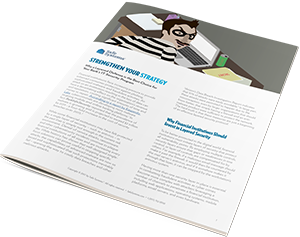Security Layers – 4 Key Areas All Bank and Credit Union CEOs Should Consider

In today’s world of escalating cyber-attacks, the importance of security layers can never be overemphasized. This is especially true for financial institutions, which are obligated to safeguard customer information, prevent identity theft, and protect their operations. No entity, computer network, or individual is unaffected by cyber threats, but a layered approach to security can significantly minimize cybercrimes.
While the IT department and security officers typically determine and recommend security measures, it is ultimately the CEO who is responsible for the overall health and well-being of the bank or credit union. Therefore, CEOs of financial institutions should be thinking about and asking the following questions in this area:
- Is there a security layer that most networks are missing?
Monitoring the internal network, outside of the endpoints, is important and an area that many banks and credit unions don’t focus on. While most organizations have perimeter defense technologies, such as firewalls and intrusion prevention systems and endpoint technologies like anti-malware software, many don’t pay close enough attention to the internal network itself. Having stronger internal network security is vital to prevent breaches and internal attacks and makes for a stronger overall network.
- What is the single most effective layer?
User training is hands down the most effective layer. Users are considered to be the first line of defense, and sadly are often seen as the weakest link in the security chain. To strengthen this link and prevent attacks, user education and training is important.
- What are some security layers all banks and credit unions should have?
Security layers represent multiple levels of defense against potential bad actors and cyber-attacks. As such, a layered security program should involve a variety of components, depending on the assets protected, vulnerabilities, and the institution’s operations. A layered security program entails using different controls at different points in a transaction process. The underlying strategy is that a weakness in one control is generally compensated for by the strength of another control.
According to the Federal Financial Institutions Examination Council (FFIEC), some effective controls that can support layered security are:
- fraud detection and monitoring systems that include consideration of customer history and behavior and enable a timely and effective institution response;
- using dual customer authorization through different access devices;
- using out-of-band verification for transaction;
- a thorough and up-to-date patch management system;
- vulnerability scanning and penetration testing; and
- end-point security and resilience controls.
- What are the three main types of controls?
Security controls generally fall into three types: protective, detective, and reactive (or corrective). Protective controls are tactics a bank or credit union can implement to prepare for and prevent a cyberattack. They encompass things like dual controls, segregation of duties, system password policies, access control lists, training, and physical access controls. Detective controls indicate that a cyberattack is taking place. Even the audit process can be detective because it uncovers control weaknesses by looking for failures after they have happened. Reactive controls are implemented to respond to an attack in progress. Essentially, they’re intended to mitigate exposure after something happens.
New types of cyber-threats and incidents are constantly emerging, and CEOs need to be prepared to protect their institutions and the data they house. With the proper controls, layered security can be an effective way for financial institutions to defend network perimeters and endpoints against potential cyber threats. There are many other areas related to security layers that CEOs and senior management should be considering. To gain more insight into those areas, as well as other key topics for CEOs to be aware of, download our white paper, Top IT Areas Where CEOs of Financial Institutions Should Focus: Important Questions and Answers.
Strengthen Your Strategy: Why a Layered Defense is the Best Choice for Your Bank’s IT Security Program
Learn why a single layer of security, such as antivirus, is no longer enough in the current risk environment.



